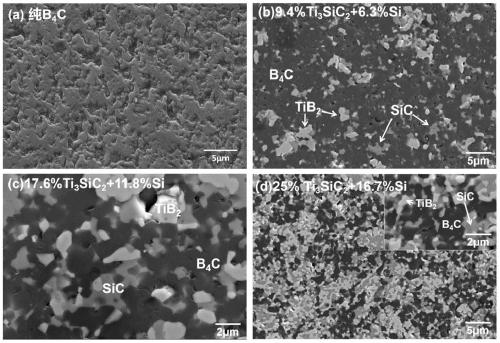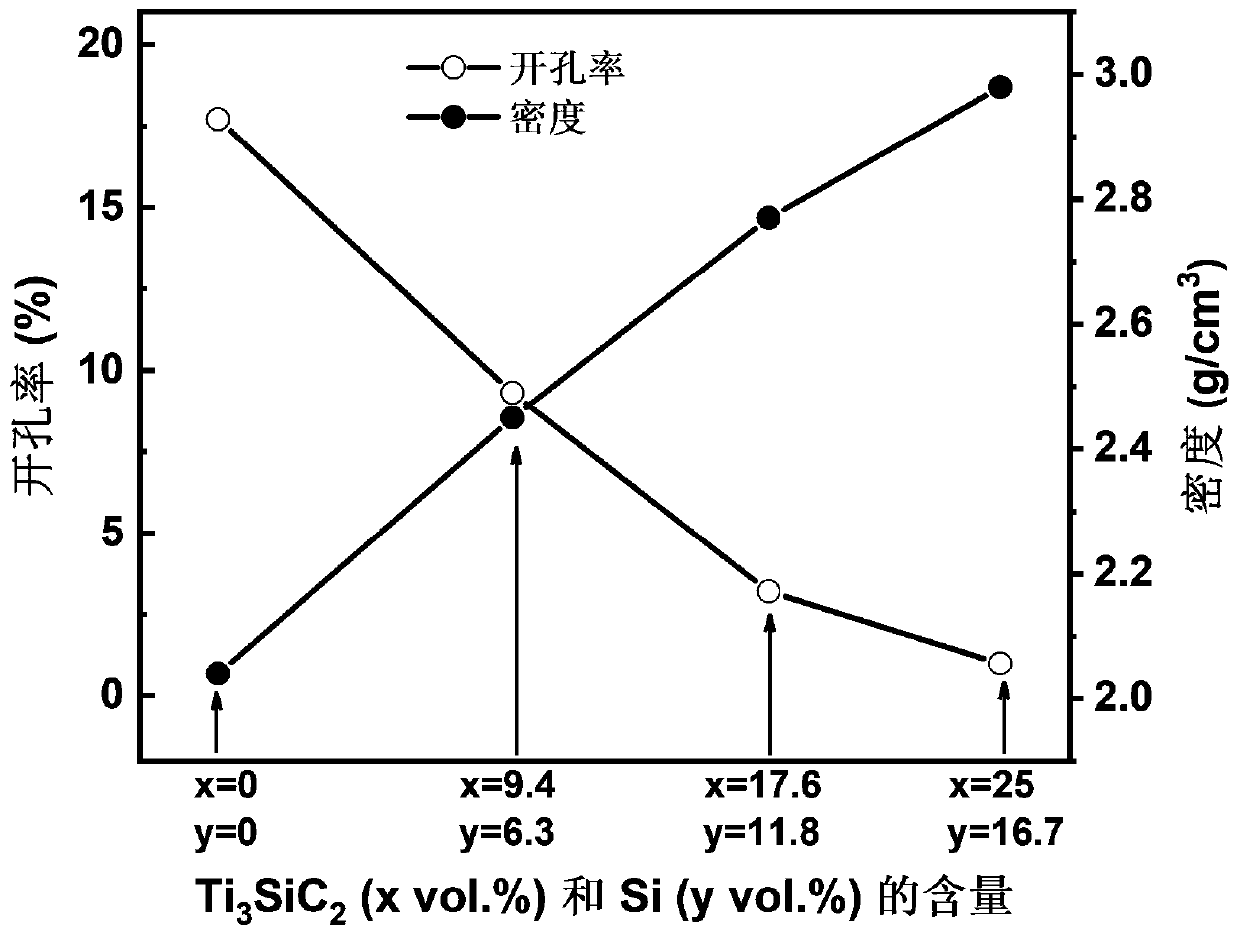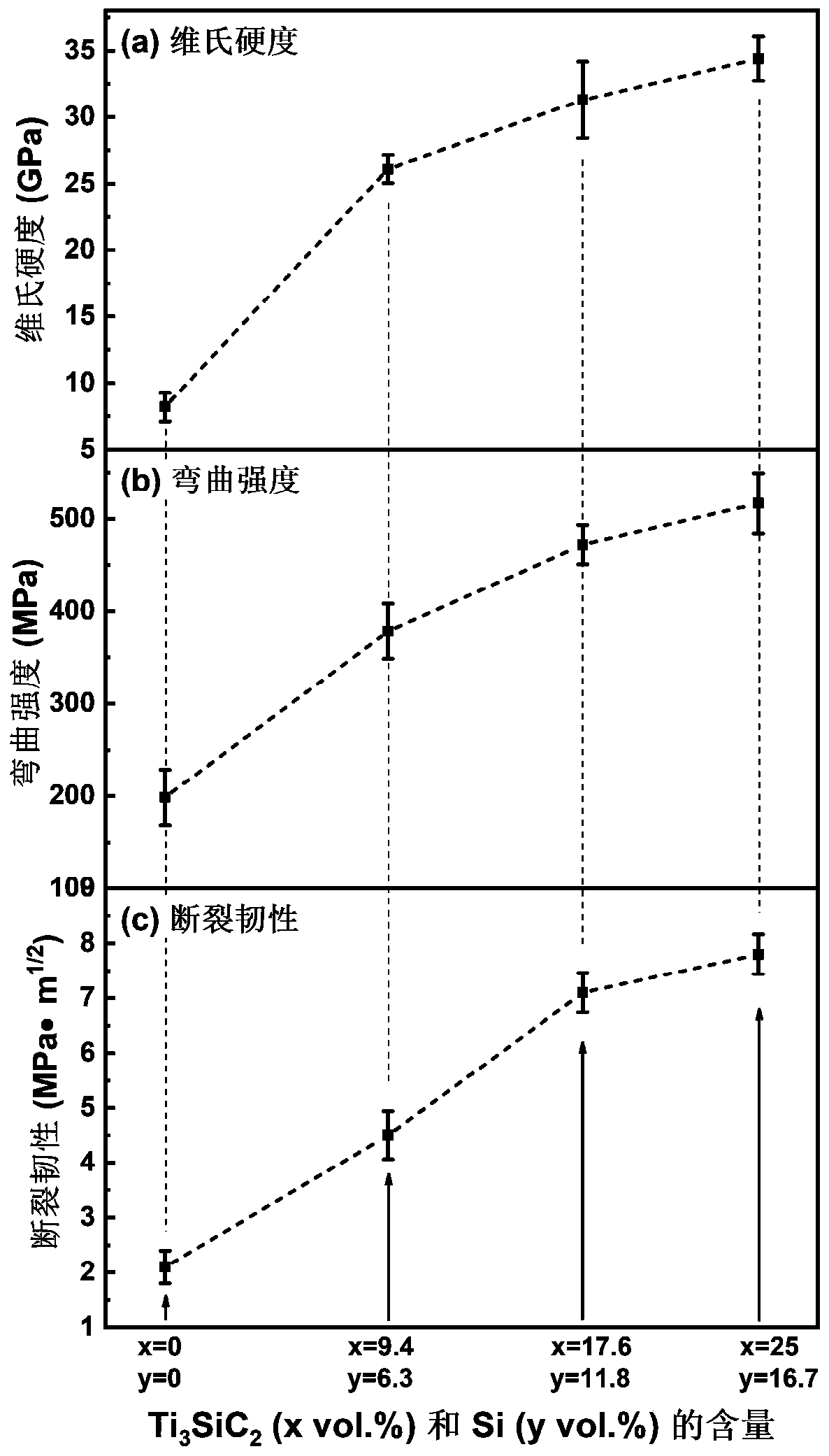Boron carbide-based composite ceramic material and preparation process thereof
A composite ceramic and boron carbide technology, which is applied in the field of reaction sintering of B4C-based composite ceramics, can solve problems such as improving the fracture toughness of ceramics, and achieve the effects of inhibiting grain growth, reducing sintering temperature and uniform distribution.
- Summary
- Abstract
- Description
- Claims
- Application Information
AI Technical Summary
Problems solved by technology
Method used
Image
Examples
Embodiment 1
[0034] This embodiment prepares B by in situ reaction hot pressing sintering 4 The sintering process of C-based composite ceramic materials is as follows:
[0035] Step 1: Preparation of reaction sintering hybrid powder
[0036] According to volume percentage, weigh 84.3% B 4 C powder, 9.4% Ti 3 SiC 2 powder and 6.3% Si powder, pour the three powders into a ball milling tank, use absolute alcohol as the ball milling medium, ball mill for 8 hours until completely mixed, and then place it in a vacuum drying oven at 50°C for 12 hours to obtain a reaction sintered mixed powder ;
[0037] Step 2: In situ reaction hot pressing sintering
[0038] Prepare a graphite mold with an inner diameter of 50mm, two matching graphite indenters, two graphite gaskets, and graphite paper; cut the graphite paper into two circular graphite papers with a diameter of 50mm and a rectangle that just covers the inner wall of the graphite mold Graphite paper: Paste the rectangular graphite paper on ...
Embodiment 2
[0042] This embodiment prepares B by in situ reaction hot pressing sintering 4 The sintering process of C-based composite ceramic materials is as follows:
[0043] Step 1: Preparation of reaction sintering hybrid powder
[0044] According to volume percentage, weigh 70.5% B 4 C powder, 17.6% Ti 3 SiC 2 powder and 11.8% Si powder, pour the three powders into a ball milling tank, use absolute alcohol as the ball milling medium, ball mill for 8 hours until they are completely mixed, and then place them in a vacuum drying oven at 50°C for 12 hours to obtain the reaction sintering mixed powder ;
[0045] Step 2: In situ reaction hot pressing sintering
[0046] Prepare a graphite mold with an inner diameter of 50mm, two matching graphite indenters, two graphite gaskets, and graphite paper; cut the graphite paper into two circular graphite papers with a diameter of 50mm and a rectangle that just covers the inner wall of the graphite mold Graphite paper: Paste the rectangular gr...
Embodiment 3
[0050] This embodiment prepares B by in situ reaction hot pressing sintering 4 The sintering process of C-based composite ceramic materials is as follows:
[0051] Step 1: Preparation of reaction sintering hybrid powder
[0052] According to volume percentage, weigh 58.3% B 4 C powder, 25% Ti 3 SiC 2 powder and 16.7% Si powder, pour the three powders into a ball milling tank, use absolute alcohol as the ball milling medium, ball mill for 8 hours until completely mixed, and then place them in a vacuum drying oven at 50°C for 12 hours to obtain the reaction sintering mixed powder ;
[0053] Step 2: In situ reaction hot pressing sintering
[0054] Prepare a graphite mold with an inner diameter of 50mm, two matching graphite indenters, two graphite gaskets, and graphite paper; cut the graphite paper into two circular graphite papers with a diameter of 50mm and a rectangle that just covers the inner wall of the graphite mold Graphite paper: Paste the rectangular graphite pape...
PUM
| Property | Measurement | Unit |
|---|---|---|
| Fracture toughness | aaaaa | aaaaa |
| Fracture toughness | aaaaa | aaaaa |
| Fracture toughness | aaaaa | aaaaa |
Abstract
Description
Claims
Application Information
 Login to View More
Login to View More - R&D Engineer
- R&D Manager
- IP Professional
- Industry Leading Data Capabilities
- Powerful AI technology
- Patent DNA Extraction
Browse by: Latest US Patents, China's latest patents, Technical Efficacy Thesaurus, Application Domain, Technology Topic, Popular Technical Reports.
© 2024 PatSnap. All rights reserved.Legal|Privacy policy|Modern Slavery Act Transparency Statement|Sitemap|About US| Contact US: help@patsnap.com










